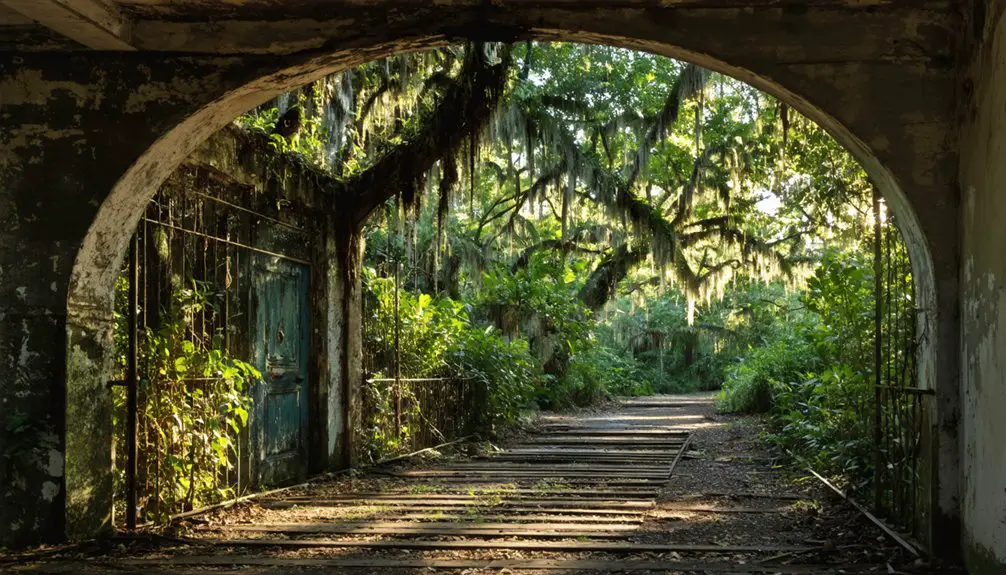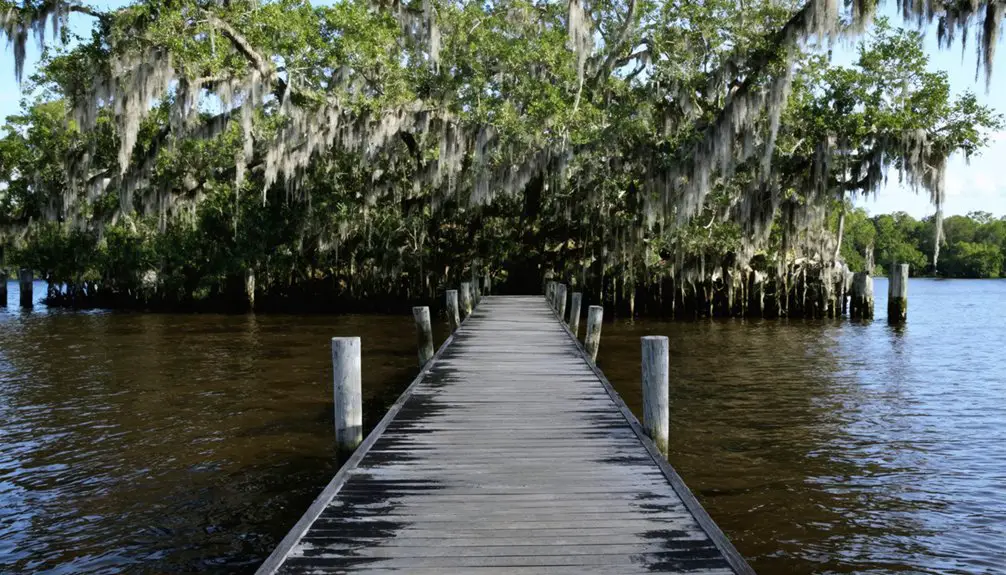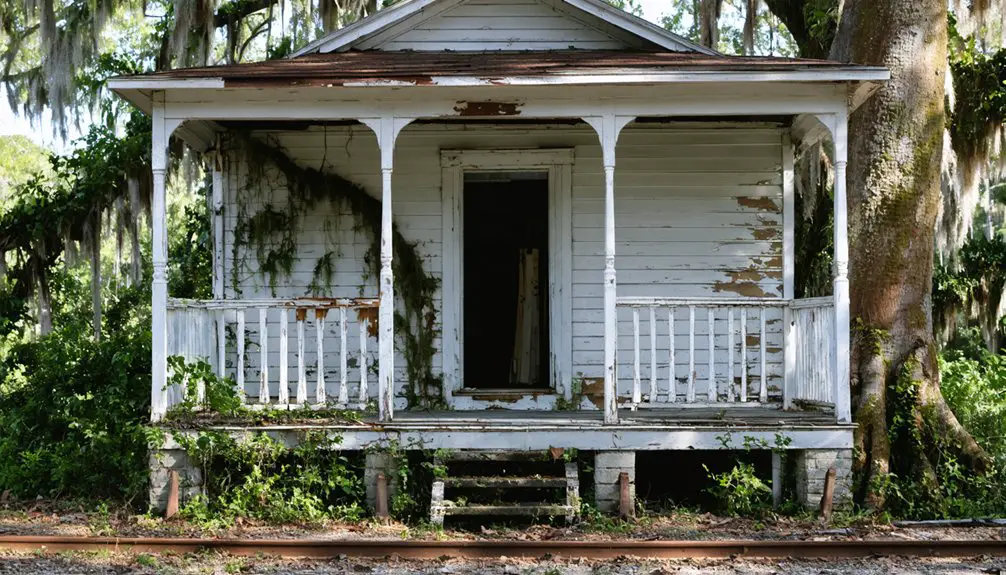You’ll find Eden, a ghost town along Florida’s Indian River, named by Captain Thomas E. Richards in 1870 for its paradise-like setting. The settlement thrived through the 1880s with its iconic Eden House, 1,500-foot dock, and prosperous pineapple plantations. Natural disasters, including the devastating Big Freeze of 1894-1895, led to Eden’s decline. Today, architectural remnants and overgrown plantation ruins tell the story of this once-bustling riverside community’s rise and fall.
Key Takeaways
- Eden was established in 1870 along Florida’s Indian River, thriving as a pineapple plantation and boarding house community until natural disasters struck.
- The settlement’s economic backbone consisted of pineapple farming, fishing, and tourism centered around the Eden House and 1,500-foot dock.
- The devastating Big Freeze of 1894-1895 destroyed Eden’s agricultural foundation, marking the beginning of the community’s decline toward ghost town status.
- Eden’s transformation from bustling community to ghost town accelerated after World War I when boarding houses closed and economic opportunities diminished.
- Today, remnants include the Eden House, fragments of the original post office, and abandoned agricultural infrastructure along the Indian River ridge.
A Biblical Name in the Sunshine State
While many Florida settlements adopted biblical names in the 19th century, Eden’s naming in 1870 by Captain Thomas E. Richards directly referenced the Garden of Eden, reflecting a wider cultural trend of using biblical symbolism to establish community identity.
You’ll find that Eden’s location along the Indian River’s natural beauty perfectly matched its paradisiacal namesake.
The two-story Eden House, built from river-transported lumber, became both a family residence and boarding house, embodying the welcoming spirit early settlers sought to create. Captain Richards established first pineapple plantation on Florida’s mainland, demonstrating the area’s agricultural potential.
Daily life revolved around essential services as the mail steamer made regular stops, connecting the isolated community to the outside world.
Like many frontier communities, Eden’s biblical name carried deeper meaning, representing cultural heritage and the promise of a fresh start.
Though the town later became a ghost settlement, its naming exemplifies how 19th-century Floridians used religious references to shape their sense of place and purpose.
The Legacy of Eden House
Standing as a tribute to Florida’s pioneer spirit, the two-story Eden House emerged in the early 1880s through the determined efforts of Captain Thomas E. Richards, who transported lumber down the Indian River to build his vision of paradise.
You’ll find this enduring structure served multiple roles – a family dwelling, boarding house, and community hub that fostered local growth and tourism. The property evolved into a thriving pineapple plantation by 1881.
Today, Eden House remains one of the area’s oldest buildings, showcasing Florida vernacular architecture adapted to local conditions. The house was established in Saint Lucie County, where its historical presence continues to draw visitors.
Surviving the test of time, Eden House stands as a testament to Florida’s practical architectural wisdom, shaped by climate and necessity.
Its cultural heritage lives on through preserved elements of the original design, despite additions made in the 1990s.
Through Lucie Richards’ letters and local historians’ documentation, you can trace the property’s significance in shaping early settlement life along the Indian River, where pioneers carved out their own piece of Eden.
Life Along the Indian River
Long before Eden House took shape along its shores, the Indian River teemed with native life and cultural exchange. The Ais, Creek, and Alachua tribes mastered the lagoon’s resources, establishing a rich indigenous heritage that would influence generations to come.
You’d find the river’s western shore bustling with activity by the 1840s, as 46 pioneering families claimed land under the Armed Occupation Act. The fishing industry thrived, drawing settlers who’d establish permanent communities like Cocoa by 1860. The Susanna settlement homesteads established a notable presence with eight families on the Indian River’s western bank.
You could’ve witnessed steamboats cutting through the waters, carrying goods and travelers before the Jacksonville-to-Miami railroad transformed transportation. Fort Pierce emerged as a crucial trading post, while early settlers adapted to life along the waterway, harvesting seafood and building a new future amid the pristine coastal landscape. These waterways became vital channels for food and transportation, sustaining both native peoples and new settlers who relied heavily on the lagoon’s abundance.
Natural Disasters and Economic Shifts
Despite Eden’s early promise as a thriving agricultural settlement, a series of devastating natural disasters and economic shifts in the late 19th century marked the beginning of its decline.
The region’s lack of disaster preparedness left it vulnerable to hurricanes and tropical storms, which repeatedly flooded the area and damaged crucial infrastructure. The local stinking cedar trees, once abundant in the region, were also severely impacted by these storms. The area near the Apalachicola River had long been considered sacred ground by some religious scholars.
The catastrophic Big Freeze of 1894-1895 dealt a crushing blow to Eden’s agricultural foundation, destroying pineapple plantations and citrus crops.
The devastating winter of 1894 shattered Eden’s farming dreams as freezing temperatures decimated its vital fruit crops.
Without economic resilience to weather these setbacks, the community faced mounting challenges as transportation routes bypassed the settlement.
The shift from river to rail transport isolated Eden from broader markets, while crop diseases and declining agricultural viability forced residents to seek opportunities elsewhere.
These combined pressures transformed Eden from a bustling community into a ghost town.
Remnants of a Forgotten Community
If you visit Eden today, you’ll find Eden House, built in 1870 by Capt. Thomas E. Richards, standing as one of the most prominent remnants alongside several converted farm buildings and the renovated church parsonage.
The original settlement’s layout reveals strategic positioning along a high ridge facing the Indian River, though many of the historical river access points have become overgrown and difficult to locate.
The site’s physical structures, including fragments of the original post office and scattered pineapple bromeliads from the old plantation, paint a picture of a once-thriving community that capitalized on both agriculture and river commerce.
Physical Structures Still Standing
While Eden, Florida has largely faded into history, several significant structures from its past remain standing in various states of preservation.
For those interested in historic preservation, you’ll discover architectural remnants scattered across the original settlement site, including:
- The “Big House,” partially relocated from Orange Park in the 1870s and expanded in the 1990s, still occupies its original position.
- The converted Eden Church parsonage, now serving as a residential dwelling.
- The salvaged portion of Eden’s original post office “shack.”
Like the historic miniature train tracks that once delighted visitors at Michigan’s Eden Springs Park, remnants of transportation infrastructure can still be found throughout the grounds.
Similar to the old brick roads of Egmont Key, you’ll find renovated farm buildings representing different construction periods and agricultural uses throughout the property.
On the high ridge facing Indian River, you can trace the foundations of Capt. Thomas E. Richards’ plantation era, while remnants of a unique Macaw rookery add character to Eden’s surviving structures.
Lost River Access Points
Beyond the surviving structures of Eden, the settlement’s most significant features were its extensive river access points along the Indian River.
You’ll find Eden’s dock stretched an impressive 1,500 feet into the water, equipped with a tram system that revolutionized pineapple transport from local packing houses to awaiting riverboats.
These transportation routes held immense historical significance as the community’s lifeline before railroad expansion in 1894.
The dock served as a crucial shipping point for “Indian River Pines,” connecting Eden’s agricultural bounty to broader markets.
While most physical remnants have deteriorated or submerged beneath the river’s surface, these lost access points tell the story of a thriving settlement that masterfully integrated water and rail transport, establishing itself as one of the region’s premier freight hubs.
Abandoned Settlement Layout
Situated on a high ridge overlooking the Indian River, Eden’s abandoned settlement layout reveals the skeletal remains of what was once a thriving 19th-century agricultural community.
The settlement patterns centered around the “big house,” which still stands as a monument to Eden’s agricultural history, having been relocated from Orange Park in the 1870s.
You’ll find these key structures that defined Eden’s layout:
- The Wesley House (Eden Mansion), a Florida Cracker-style residence with Victorian elements
- The original post office shack, attached to what was once a larger residence
- Farm-related buildings scattered across the property, including a rookery now home to Macaws
Remnants of the pineapple plantation’s infrastructure persist, with original bromeliads still growing wild among the overgrown landscape where a 1,500-foot dock once stretched into the river.
Early Tourism and Settlement Patterns

You’ll find Eden’s early tourism emerged through its strategic position on the Indian River, where the 1500-foot dock served both commerce and visitors arriving by boat in the late 1800s.
The community’s riverside location attracted travelers who found accommodation in local boarding houses, creating a modest visitor economy that complemented the agricultural operations.
Eden’s blend of hospitality and trade shaped its initial settlement patterns, as structures were positioned to maximize both river access and connections to the agricultural plantations that defined the area.
River Access Tourism Benefits
During Eden’s early development, the Indian River served as more than just a transportation route – it became a powerful draw for tourism and settlement along Florida’s eastern coast.
The river access brought significant tourism benefits through attractions like Callaway’s Garden of Eden, which capitalized on scenic river views and nature-focused experiences.
You’ll discover how the river shaped Eden’s early tourism appeal through:
- Biblical-themed walking trails with interpretive markers overlooking the waterway
- Natural overlooks that showcased the pristine river landscape
- Roadside attractions that drew visitors to experience the region’s unique riverside culture
This riverside tourism complemented Eden’s agricultural economy, creating additional revenue streams while highlighting the natural beauty that initially attracted settlers to this untamed Florida wilderness.
Boarding House Visitor Economy
Boarding houses formed the backbone of Eden’s early visitor economy, serving as essential hubs for both transient workers and tourists in the late 19th and early 20th centuries.
You’d find these establishments strategically positioned near Eden’s railway depot and riverfront, where they catered to lumber workers, pineapple farm laborers, and early tourists exploring the Indian River region.
The boarding house economics thrived during the industrial peak, with establishments like those near Wesley Lumber Company creating vibrant community centers.
This hospitality evolution shaped Eden’s early neighborhoods and settlement patterns. When you visited, you’d experience the social mixing of locals and travelers, fostering community connections.
After WWI, though, the decline of lumber and pineapple industries triggered a transformation, with many boarding houses closing or converting to new uses, forever changing Eden’s visitor landscape.
Early Settlement Hospitality Patterns
While Captain Thomas E. Richards established Eden’s first European settlement, the area’s hospitality evolution began with practical pioneer accommodations.
You’ll find early hosting patterns emerged from necessity rather than leisure, as settlers created spaces to welcome newcomers and traveling businessmen.
The region’s early hospitality development followed three distinct patterns:
- Repurposed military structures served as temporary lodging for arriving families.
- The Al Fresco Hotel’s 1890s construction marked a shift toward formal accommodations, featuring 40 rooms and elegant gardens.
- Dr. Weedon’s converted buildings provided essential shelter for wilderness changeover periods.
These patterns shaped Eden’s growth, especially near transportation hubs where the Florida East Coast Railway and Indian River docks connected visitors to the settlement.
The community’s hosting traditions reflected the pioneer spirit, emphasizing practical shelter over luxury.
Geographic Significance and River Commerce

Located strategically along the Indian River Drive north of the Martin/St Lucie county line, Eden’s geographic significance stemmed from its prime position within Florida’s Indian River Lagoon system.
You’ll find this former settlement nestled in a region where rich river ecology supported both commerce and daily life, with warm breezes and navigable waterways that once drew settlers to its shores.
The town’s proximity to the Apalachicola River system enhanced its historical trade potential, enabling small vessels to transport timber and agricultural goods between local markets and larger ports.
Unique geographical features, including bluffs and steephead ravines, created natural harbors for river commerce.
While nature has since reclaimed many of the old docks and trading posts, Eden’s position along these crucial waterways made it a promising settlement before environmental challenges led to its decline.
Frequently Asked Questions
What Happened to the Descendants of Captain Thomas E. Richards?
You’ll find the Richards legacy dispersed after the 1930s deaths of Harry, Lucie, and Franklin, though their family history lived on through the Eden Grove House until it burned in 1986.
How Many People Lived in Eden During Its Peak Population?
You’ll find Eden’s peak demographics weren’t precisely recorded, but based on comparable Florida ghost towns and regional patterns, it likely housed between 200-500 residents before its population decline in the early 1900s.
Were There Any Schools or Churches Established in Eden?
You’ll find Eden had an established church with a parsonage that’s still standing today. While formal education records don’t exist, it’s likely children received informal schooling or attended classes in nearby communities.
What Native American Tribes Originally Inhabited the Eden Area?
You’ll find the Seminole and Miccosukee tribes shaped Eden’s Native heritage, while earlier tribal influences included the Creek Indians, Fort Walton culture, and Belle Glade culture throughout Florida’s pre-Columbian period.
Did Any Other Significant Buildings Besides Eden House Exist in Town?
You’ll find several historic landmarks besides Eden House, including a parsonage, farm buildings, a small post office shack, and the Wesley Mansion with its Florida Cracker-style architecture and Victorian details.
References
- https://stluciehistoricalsociety.net/lucie-richards-life-in-eden-circa-1883/
- https://www.journaloffloridastudies.org/0102ghosttowns.html
- https://www.exploresouthernhistory.com/apalachicolabluffs2.html
- https://moonmausoleum.com/the-wailing-bride-haunting-the-eden-brown-estate-in-nevis/
- https://www.clickorlando.com/features/2025/01/14/is-the-biblical-garden-of-eden-really-found-in-this-florida-state-park/
- https://www.youtube.com/watch?v=sjs5pLAp77I
- https://www.ghosttowns.com/states/fl/eden.html
- https://dos.fl.gov/historical/preservation/national-register/recent-national-register-listings/eden-mansion/
- https://stars.library.ucf.edu/cgi/viewcontent.cgi?article=2920&context=fhq
- https://helpthelagoon.org/history-indian-river-lagoon/



